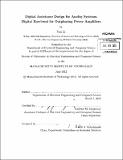| dc.contributor.advisor | Vladimir M. Stojanović. | en_US |
| dc.contributor.author | Li, Yan, Ph. D. Massachusetts Institute of Technology. Department of Electrical Engineering and Computer Science | en_US |
| dc.contributor.other | Massachusetts Institute of Technology. Department of Electrical Engineering and Computer Science. | en_US |
| dc.date.accessioned | 2013-11-18T19:12:34Z | |
| dc.date.available | 2013-11-18T19:12:34Z | |
| dc.date.copyright | 2013 | en_US |
| dc.date.issued | 2013 | en_US |
| dc.identifier.uri | http://hdl.handle.net/1721.1/82353 | |
| dc.description | Thesis (Ph. D.)--Massachusetts Institute of Technology, Dept. of Electrical Engineering and Computer Science, 2013. | en_US |
| dc.description | Cataloged from PDF version of thesis. | en_US |
| dc.description | Includes bibliographical references (p. 145-150). | en_US |
| dc.description.abstract | Digital assistance is among many aspects that can be leveraged to help analog/mixed-signal designers keep up with the technology scaling. It usually takes the form of predistorter or compensator in an analog/mixed-signal system and helps compensate the nonidealities in the system. Digital assistance takes advantage of the process scaling with faster speed and a higher level of integration. When a digital system is co-optimized with system modeling techniques, digital assistance usually becomes a key enabling block for the high performance of the overall system. This thesis presents the design of digital assistances through the digital baseband design for outphasing power amplifiers. In the digital baseband design, this thesis conveys two major points: the importance of the use of the reduced-complexity system modeling techniques, and the communications between hardware design and system modeling. These points greatly help the success in the design of the energy-efficient baseband. The first part of the baseband design is to realize the nonlinear signal processing unit required by the modulation scheme. Conventional approaches of implementing this functionality do not scale well to meet the throughput, area and energy-efficiency targets. We propose a novel fixed-point piece-wise linear approximation technique for the nonlinear function computations involved in the signal processing unit. The new technique allows us to achieve an energy and area-efficient design with a throughput of 3.4Gsamples/s. Compared to the projected previous designs, our design shows 2x improvement in energy-efficiency and 25x in area-efficiency. The second part of the baseband design devotes to the nonlinear compensator design, aiming to improve the linearity performance of the outphasing power amplifier. We first explore the feasibility of a working compensator by use of an off-line iterative solving scheme. With the confirmation that a compensator does exist, we analyze the structure of the nonlinear baseband-equivalent PA system and create a dynamical real-time compensator model. The resulting compensator provides the overall PA system with around 10dB improvement in ACPR and up to 2.5% in EVM. | en_US |
| dc.description.statementofresponsibility | by Yan Li. | en_US |
| dc.format.extent | 150 p. | en_US |
| dc.language.iso | eng | en_US |
| dc.publisher | Massachusetts Institute of Technology | en_US |
| dc.rights | M.I.T. theses are protected by
copyright. They may be viewed from this source for any purpose, but
reproduction or distribution in any format is prohibited without written
permission. See provided URL for inquiries about permission. | en_US |
| dc.rights.uri | http://dspace.mit.edu/handle/1721.1/7582 | en_US |
| dc.subject | Electrical Engineering and Computer Science. | en_US |
| dc.title | Digital assistance design for analog systems : digital baseband for outphasing power amplifiers | en_US |
| dc.type | Thesis | en_US |
| dc.description.degree | Ph.D. | en_US |
| dc.contributor.department | Massachusetts Institute of Technology. Department of Electrical Engineering and Computer Science | |
| dc.identifier.oclc | 861744092 | en_US |
